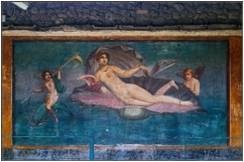The Birth of Aphrodite in Greek poetry
Dr Maria Hristova is assistant professor in the Ethnology and Balkan Studies Department at the Faculty of Philology of South-West University "Neofit Rilski". She took part in this year's tenth jubilee Ionian Congress with a paper entitled "The Eternal Trip to Kythira: The Image of Aphrodite Anadyomene in the Works of Dionysios Solomos, Lorentzos Mavilis and Angelos Sikelianos," examining the literary incarnations of myths associated with goddess Aphrodite in the works of these three great Greek poets.
According to the account by Homer the goddess was born at Petra tou Romiou (Πέτρα του Ρωμιού), a coastal monolith near Paphos in Cyprus. Carried by the god of the west wind, Zephyros, on the sea waves, she reached Olympus, where she was introduced to Zeus and the other gods. According to Hesiod's version of the genealogy of the gods in his Theogony, Aphrodite was born near the Ionian island of Kythira from the foam that was formed after the genitals of Uranus (Ουρανός), who was castrated by his son Cronus (Κρόνος) with the help of his mother Gaia, fell into the sea. The drops of blood gave birth to Celestial Aphrodite (Ουρανία Αφροδίτη), the goddess of love and beauty, as if Uranus was purified by sacrificing his manhood, thus creating love and perfect aesthetics. Plato says that the symbolism of this story is the existence of Celestial Aphrodite, endowed with all female sensuality, and of Eros who was born from male love. It is not a coincidence that Kythira is considered the island of Celestial Aphrodite, as her first sanctuary in the Greek lands was located there.
 Maria Hristova talks with Zdravka Mihaylova exclusively for GRReporter.
Maria Hristova talks with Zdravka Mihaylova exclusively for GRReporter.
The subject of your research is the myths about the birth of Aphrodite from the sea foam and her 'sαiling' into modern literary and cultural anthropological texts. In it you place emphasis on the intertextual presence of the ancient myth in the poetic works "Lambros" by Dionysios Solomos, "Corfu" by Lorentzos Mavilis and "Anadyomene" by Angelos Sikelianos. What does your experience in following some of the rich connotations of Aphrodite Anadyomene as an archetype and the symbol of unconscious show?
My experience shows that ancient mythology is an inexhaustible source of not only inspiration but also of self-knowledge. The myth of the birth of Aphrodite is one of the most famous and beloved myths in Greek and Western art of all ages. From ancient times to the present day, the image of the goddess who was born from the sea foam has not ceased to inspire poets, painters and sculptors, and to foster the eternal dialogue between mythology and literature. In the text that I presented at the Congress I tried to make (another) journey on the trail of the ancient goddess and to reconstruct three of her numerous incarnations in the works of these three Greek poets. I outlined the archetypal dimension of the figure and her presence in literary works. Among the many possible interpretations of the myth I focused on the image of Anadyomene as a product of the unconscious with rich and contradictory suggestions.
 Where did the chronology of the journey in the statement you made to the Ionic Congress start?
Where did the chronology of the journey in the statement you made to the Ionic Congress start?
My personal journey to explore mythology began with my work on my Ph.D. dissertation that was associated with Ancient Greek myths and their "re-playing" in Modern Greek literature. The theme of "inter-artistry" (διακαλλιτεχνικότητα), the communication between the various arts, attracted me to the figure of Aphrodite in poetry and painting. Therefore, the journey to Kythira started with a birth in 1485, "The Birth of Venus" by Sandro Botticelli, that was inspired in turn by the description of the famous work of Greek painter Apelles. The reason for including it in the study was a comment by Karl Kerényi, a Hungarian scientist, classical philologist, one of the founders of modern studies of mythology, that the masterpiece by Botticelli depicts not the birth of Aphrodite but her arrival, considering especially her arrival among us. Indeed, nothing in the gentle girl from the seashell alludes to her dire and bloody origin. The castration of the god of the sky, Uranus, by his son Cronus, his genitals that fell into the sea, the goddess carried by the waves, her birth from the foam and rise from the waters are not present in this very impressive image of the mythological heritage.
 How did connoisseur Kerényi interpret this image?
How did connoisseur Kerényi interpret this image?
The charm and perhaps the power of mythology lie in the unlimited possibility of examining and interpreting it from various optical angles. A myth always has something to tell you, regardless of the perspective from which you explore it. Kerényi and other major "connoisseurs" of mythological stories as you call them, such as Campbell, Neumann, Jung, consider the famous goddess of love as a psychic reality, an archetypal figure of vital importance for the soul. According to Kerényi the figure of Anadyomene, emerging from the seawater, precedes the arrival of Aphrodite in the mainland, and this image helps us to understand the goddesses of ancient Greeks, as Aphrodite Anadyomene "is the one who is closest to the roots."